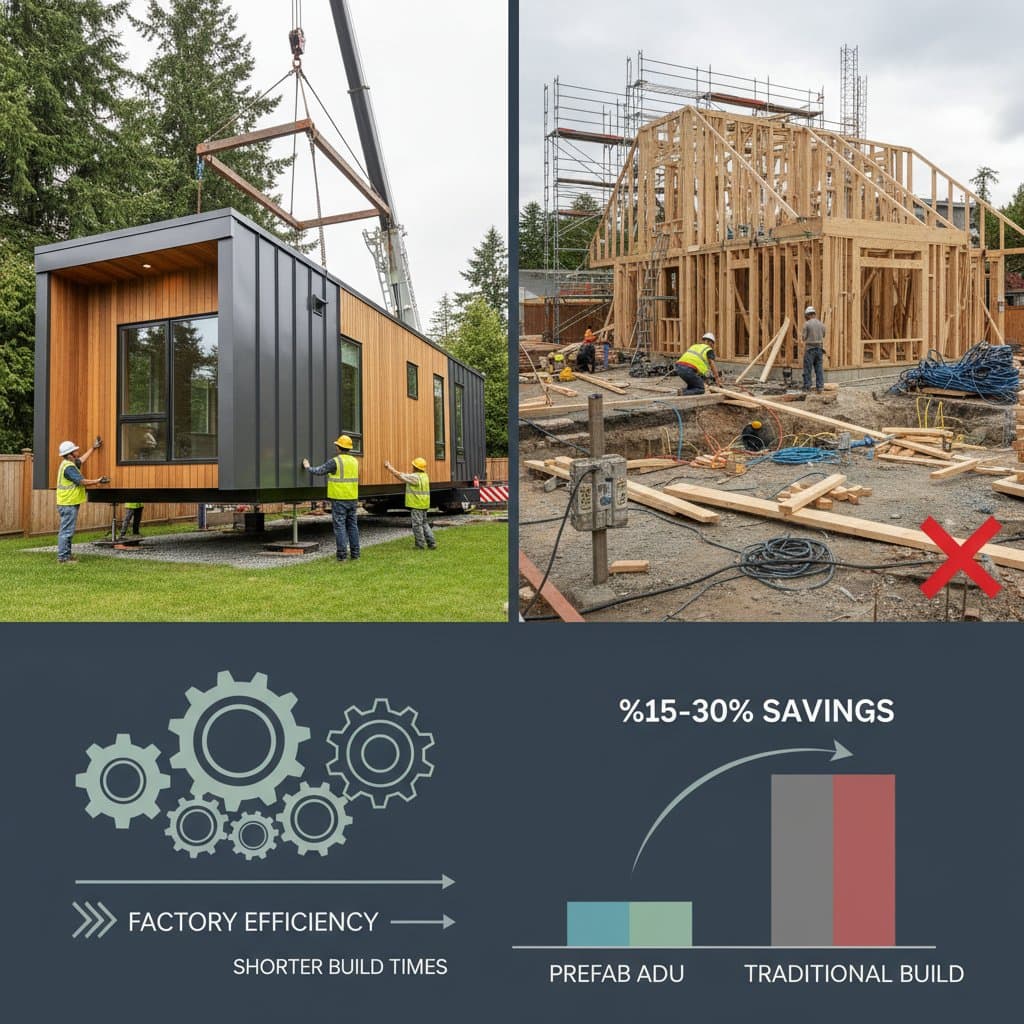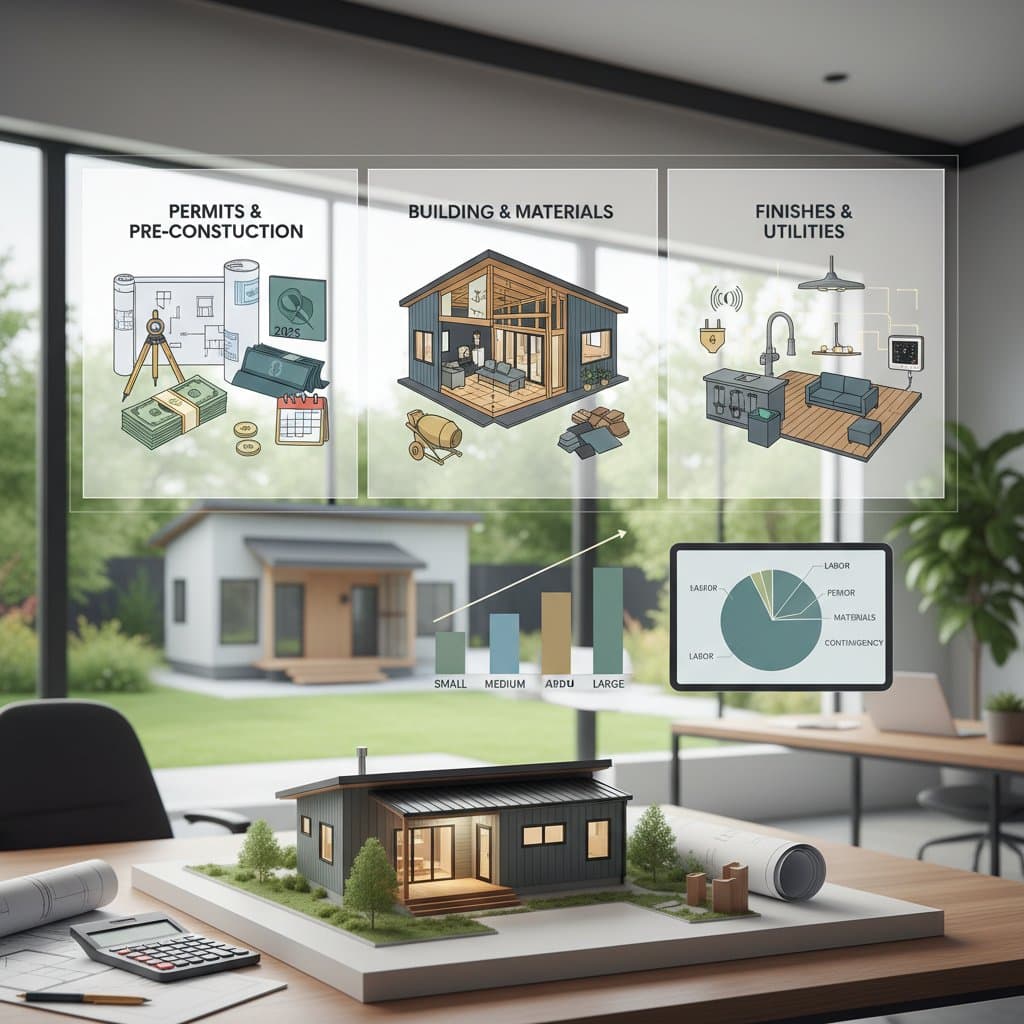2025 Prefab ADU Costs: Full Installation Breakdown
Prefab accessory dwelling units, or ADUs, represent one of the most efficient methods to add usable space and enhance property value. These compact, factory-built structures provide speed, predictability, and modern design options that traditional construction methods often fail to achieve. A clear understanding of the full cost involved enables realistic planning and helps prevent unexpected budget overruns. This guide details expectations from base unit pricing through installation and permitting processes.
What This Guide Covers
- Average prefab ADU costs based on size and finish level
- Detailed breakdown of site work, permits, and utilities
- Guidance on hiring professionals versus handling tasks independently
- Potential return on investment and effective cost-saving strategies
Breaking Down the Full Installation Cost
Prefab ADUs arrive on site in a largely complete state, yet the total expense extends beyond the unit price. The following breakdown outlines common categories of costs, providing a realistic overview for budgeting purposes.
| Category | Cost Range | Notes |
|---|---|---|
| Prefab Unit | $100,000–$250,000 | Factory-built structure delivered to the site |
| Foundation & Site Prep | $20,000–$40,000 | Includes grading, concrete pouring, and utility routing |
| Delivery & Crane Set | $5,000–$15,000 | Varies based on site access and transportation distance |
| Plumbing, Electrical, Gas | $10,000–$25,000 | Connections to the main house systems or municipal lines |
| Permits & Fees | $5,000–$15,000 | Encompasses local building permits, utility approvals, and impact fees |
| Landscaping & Driveway | $5,000–$10,000 | Optional enhancements that improve curb appeal and functionality |
| Interior Upgrades | $10,000–$25,000 | Customizations such as cabinetry, flooring, and lighting fixtures |
Every property presents distinct challenges that influence these figures. For example, properties on sloped terrain may require additional retaining walls for stability, while older homes could necessitate upgrades to the electrical panel to support increased power demands. To refine your estimate, conduct a site survey early and consult local contractors for tailored assessments.
ROI and Long-Term Value
Prefab ADUs frequently yield substantial returns, particularly in regions with strong rental markets or housing shortages. Market surveys indicate that homeowners achieve a 50 to 80 percent return on investment, influenced by factors such as unit design quality and prevailing local real estate conditions.
Typical Financial Benefits
- Rental income: Generate monthly rents ranging from $1,500 to $2,500, which can cover mortgage payments or recoup construction expenses over time.
- Property value boost: The added square footage appeals to buyers interested in multi-generational living arrangements or income-generating properties.
- Efficiency savings: These factory-built units typically surpass standard energy efficiency codes, resulting in reduced utility bills over the years.
Beyond finances, prefab ADUs offer versatility for various uses, including guest accommodations, home offices, or spaces for aging family members. This adaptability enhances both economic returns and daily living quality.
When to Hire a Professional Builder
Although prefab ADUs seem simple at first glance, their installation demands precise coordination among the manufacturer, site team, and regulatory bodies. Engage a professional builder in situations such as:
- Properties with significant grade changes or persistent drainage problems.
- Requirements for structural reinforcements or seismic retrofitting.
- Plans to integrate features like solar panels or high-efficiency HVAC systems.
- Local jurisdictions with rigorous permit evaluation timelines.
Select contractors who hold valid licenses and specialize in prefab projects. Request client references, verify insurance coverage, and review a comprehensive scope of work document prior to committing to any agreement. This preparation minimizes risks and ensures compliance with all standards.
Common Questions About Prefab ADU Costs
What factors influence prefab ADU pricing the most?
Site conditions and utility integration typically account for the largest variations in overall costs. Evaluate your property's terrain and existing infrastructure to anticipate these impacts accurately.
Does a prefab ADU require a separate foundation?
Yes, most units demand a dedicated concrete slab or pier foundation constructed in accordance with local building codes. Factor this into your timeline, as foundation work often precedes unit delivery.
How long does the installation process take after delivery?
With the site fully prepared, the placement and completion phases generally span two to six weeks. Delays can arise from weather or permitting hurdles, so build buffer time into your schedule.
Are prefab ADUs as durable as traditional homes?
Premium prefab models adhere to or surpass conventional building standards, offering longevity comparable to site-built structures when maintained properly. Focus on reputable manufacturers to ensure material quality and warranty support.
Steps to Launch Your Prefab ADU Project
A prefab ADU holds the potential to elevate your property's functionality and market appeal. Begin by examining your area's zoning regulations to confirm eligibility and any restrictions. Next, solicit detailed proposals from several manufacturers and contractors to compare options and pricing.
Anticipate site-specific expenses, such as utility modifications and permitting delays, from the outset. With thorough budgeting and expert input, you position yourself to deliver a superior prefab ADU that maximizes comfort, property value, and enduring benefits.








